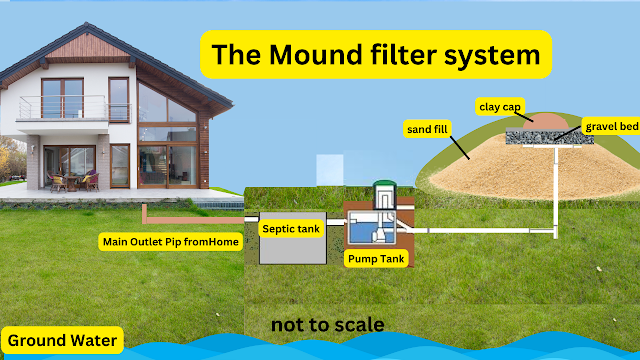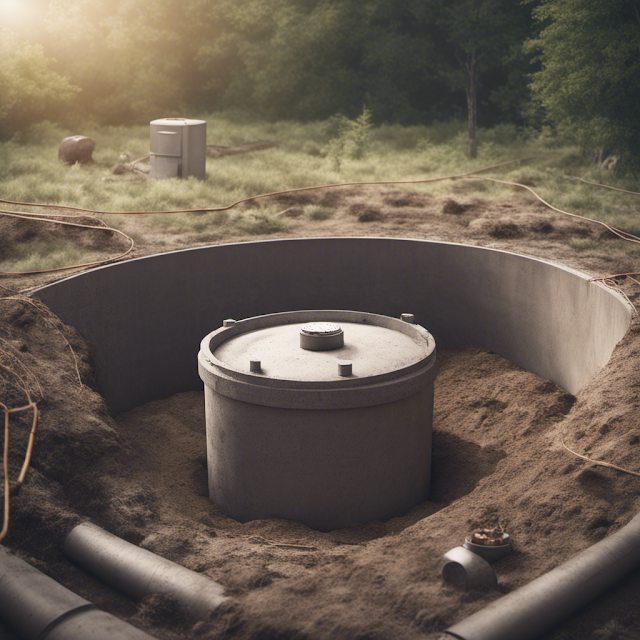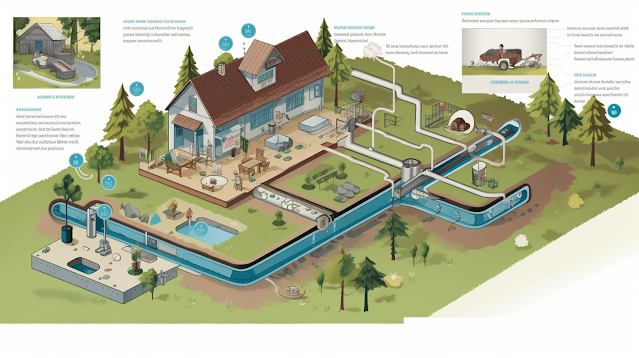Climate Change Wreaks Havoc On Septic Systems: Impact On Communities And Potential Solutions
 |
| Septic Systems and Climate Change |
Introduction
Climate change is a global phenomenon that is causing major disruptions to the environment, including the failure of septic systems. Septic systems are an essential component of many households in the US, especially those in coastal areas experiencing relative sea-level rise. However, rising waters and intensifying rains are making underground systems less effective, leading to septic failures. Without proper attention, septic systems can pose significant health risks, and the impact of septic failures is often felt disproportionately by low-income and disadvantaged communities who have settled in areas with poor soils.
The impact of septic failures on communities is significant, affecting both the health and economic wellbeing of individuals. Failure of septic systems can lead to the contamination of groundwater, which can cause waterborne diseases such as cholera and typhoid fever. The economic cost of septic failures is also significant, as it can require expensive repairs and replacements. Additionally, septic failures can lead to property damage and decreased property values, further impacting the financial stability of households.
As such, understanding the causes of septic failures, their impact on vulnerable areas, and potential solutions is critical in addressing the issue and mitigating its impact on communities.
Key Takeaways
- Climate change is causing septic system failures, particularly in coastal areas experiencing rising sea levels and intensifying rains.
- Low-income and disadvantaged communities are disproportionately affected by septic system failures, as they are more likely to settle in areas with poor soils that compromise the systems.
- Converting septic systems to central sewer systems is a potential solution, but can be costly and may be a barrier for low-income communities.
- Failing to address the problem of septic system failures due to climate change could erase decades of environmental progress.
Causes of Failure
The causes of failure of septic systems due to climate change, including rising waters and intensifying rains, have been identified as major factors affecting the effectiveness of underground septic systems. These factors have made it increasingly difficult for septic systems to function properly, resulting in a rise in septic system failures.
The impact of these failures has been felt disproportionately by low-income and disadvantaged communities who settled in areas with poor soils that compromise septic systems. Additionally, the lack of adequate septic system maintenance requirements and outdated regulatory standards have further exacerbated the issue.
The inability of conventional septic systems to handle the effects of climate change has led to the exploration of alternative septic systems that can better withstand flooding and other extreme weather events. However, these alternative systems have also been found to be inadequate in handling the effects of climate change.
Given the increasing frequency and severity of climate change-related weather events, there is a need for an overhaul of septic system regulations to ensure that they are equipped to handle the changing climate. Such regulation reform would require the collaboration of industry professionals, government agencies, and local communities to develop sustainable solutions that can mitigate the impact of climate change on septic systems.
Impact on Vulnerable Areas
Low-income and disadvantaged residents in areas with poor soil quality are disproportionately affected by septic system failures, exacerbating existing inequalities. As climate change intensifies, rising sea levels and more frequent and severe storms compromise septic systems, leading to significant health and environmental risks in vulnerable areas.
The impact of septic failures on these communities is particularly severe, as they often lack the resources to address the issue. The pollution caused by septic systems can also lead to the closure of shellfish harvests and the death of fish, further harming the livelihoods of local residents.
To address the impact of septic system failures on vulnerable areas, a concerted effort is needed to promote environmental justice and community adaptation. This includes improving maintenance requirements for septic systems, updating permitting standards to account for changing climate conditions, and exploring alternative solutions to elevate septic systems.
Additionally, communities must be provided with affordable and accessible options to connect to central sewer systems, as the cost of conversion is often prohibitive for low-income residents. By prioritizing the needs of vulnerable communities and investing in sustainable solutions, we can address the impact of septic system failures on community health and environmental well-being.
Cost and Access Issues
Affordability and accessibility of central sewer connections present significant challenges for residents in areas with failing septic systems. The cost to convert septic systems into a central sewer plant can be a barrier for low-income communities, who are already disproportionately affected by the impact of septic failures.
For instance, Miami-Dade County has a porous limestone bedrock problem, with about half of the area's 120,000 septic tanks being compromised during storms or wet years. The solution is to connect properties to a central sewer system, beginning with the most-threatened areas. However, connecting can cost between $5,000 and $20,000, which may be unaffordable for many residents.
The high cost of central sewer connections raises equity concerns, as low-income communities may not be able to afford the improvements needed to protect their homes from the impact of climate change. The cost to convert Florida's systems into a central sewer plant would be more than $4 billion, which is a significant financial burden for the state.
In some cases, property owners may be given the option to tie into a sewer system, but it may come at a high cost that they cannot afford. This highlights the need for policymakers to develop equitable solutions that prioritize vulnerable communities and address affordability challenges.
Innovative Solutions
Innovative approaches are being explored to address the challenges associated with connecting failing septic systems to central sewer systems. Off-the-grid homes are one such solution that can reduce the reliance on septic systems. These homes are typically equipped with self-contained wastewater treatment systems that convert human waste into usable water. These systems can be designed to operate on renewable energy sources, such as solar or wind power, reducing the carbon footprint of the home.
Marine energy is another innovative solution that can be used to address the challenges associated with septic failures. This technology harnesses the energy generated by ocean waves to power wastewater treatment plants. These plants can be strategically placed in coastal areas experiencing septic failures to provide a sustainable solution to the problem. Additionally, marine energy can be used to power other infrastructure, such as desalination plants, reducing the reliance on fossil fuels and providing a sustainable source of energy for communities.
Larger Picture and Individual Actions
Individual responsibility and collective action are necessary to address the challenges associated with failing septic systems and reduce the environmental impact of wastewater pollution. Climate change is exacerbating the problems associated with septic systems, and individual actions can help to mitigate the impact of these changes.
For example, individuals can reduce their water usage, which can help to reduce the strain on septic systems. Additionally, individuals can adopt sustainable practices, such as composting and using environmentally-friendly products, which can help to reduce the amount of pollutants that enter the wastewater system.
In addition to individual actions, collective action is also necessary to address the challenges associated with septic systems. This can include investing in innovative technologies that can help to improve the efficiency and effectiveness of septic systems, as well as investing in the infrastructure necessary to support these systems.
Governments can also play a role in addressing the challenges associated with septic systems, by implementing policies that encourage sustainable practices and by investing in the infrastructure necessary to support these practices. By working together, individuals and communities can help to address the challenges associated with septic systems and reduce the environmental impact of wastewater pollution.
Frequently Asked Questions
Causes of Failure:
Environmental factors such as rising waters, intensifying rains, and poor soil quality can contribute to septic system failures. Proper septic system maintenance is crucial in preventing failures and addressing these environmental challenges.
What are some of the alternative septic systems that have been tried, and why have they failed?
Alternative septic technologies, such as aerobic treatment units and constructed wetlands, have been tried to address maintenance requirements and environmental concerns. However, they have not been widely adopted due to higher costs and technical challenges.
How is rising groundwater contributing to the failure of septic systems?
Groundwater contamination resulting from rising groundwater levels is contributing to the failure of septic systems. This has public health implications as the nitrogen and phosphorous from human waste can pollute waters, creating oxygen-depleted zones, and killing fish.
Impact on Vulnerable Areas:
The impact of septic tank failures in vulnerable areas has public health implications. Septic tank regulations need to be updated to address the effects of climate change. Low-income and disadvantaged communities are disproportionately affected.
Which coastal areas are particularly vulnerable to septic system failures due to climate change?
Coastal erosion and infrastructure damage due to rising waters and intensifying rains make septic systems ineffective in many US households, with New England and Florida being particularly vulnerable areas.
Conclusion
The impact of climate change on septic systems is a growing concern for communities across the United States. Rising waters and intensifying rains are making underground systems ineffective, leading to an increase in septic failures. This problem is particularly acute in coastal areas experiencing relative sea-level rise, where many low-income and disadvantaged people settled in areas with poor soils.
Efforts to address the problem of septic failures must consider factors such as the causes of failure, impact on vulnerable areas, cost and access issues, and innovative solutions. One potential solution is the use of alternative systems, such as composting toilets or decentralized wastewater treatment systems. However, these solutions may face challenges in terms of cost and regulatory approval.
In the larger picture, addressing the impact of climate change on septic systems requires a holistic approach that considers both individual actions and larger policy changes. This may involve investing in infrastructure to improve the resilience of septic systems, as well as promoting sustainable land use practices to reduce the risk of system failures.
Ultimately, addressing the impact of climate change on septic systems is essential to protecting the health and well-being of communities across the United States.
Research and Fact Checked:
.png)



.png)






Comments
Post a Comment